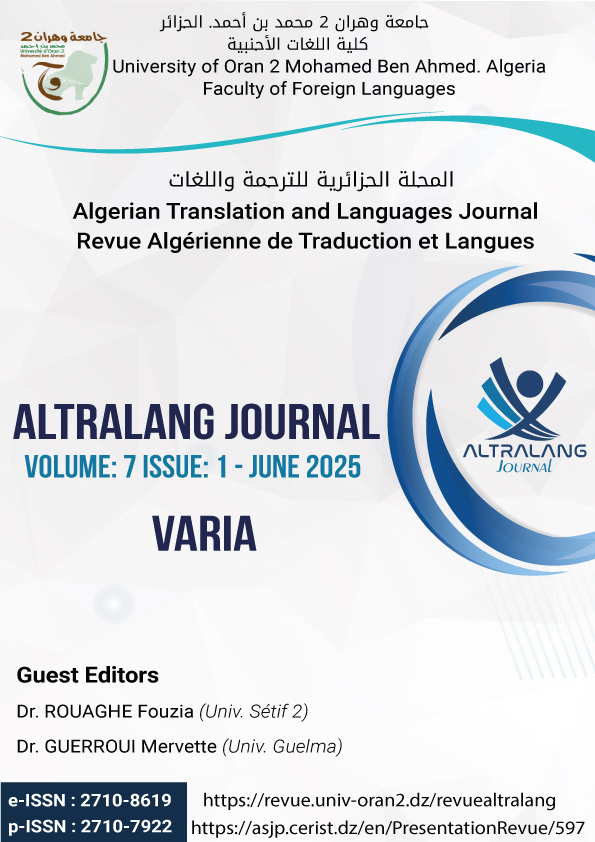Excavating the Odalisque: Rethinking Identity in the Border in Laila Lalami’s Hope and Other Dangerous Pursuits
Main Article Content
Abstract
This study explores the treatment of the issue of El harga—present-day migration—in Hope and Other Dangerous Pursuits (2005) by the Moroccan author Laila Lalami. More precisely, it targets the experience of women haragas as victims of essentializing gendered norms and neo-colonial dialectics through employing post-colonial poetics by Edward Said, Judith Butler, Gloria E. Anzaldua, in addition to Deleuze and Guattari. The study examines Faten’s journey of becomingness and reveals that the contemporary Western society displays neo-colonial attitudes and relegates migrant Arab women to the periphery following Orientalist visions of identity and sexuality. It argues that Faten’s story of self-affirmation, new consciousness and subversion of the odalisque affirms her ability to rehistoricize, recontextualize and demythologize the myopic renderings about Arab and Muslim women in the West. The article concludes by refuting the consideration of El harga as a mere border crossing through its representation as an ideological and cultural traverse leading to an emergent agency and consciousness.
[1]In this article, the term “El harga” or “lahrig” is a noun coming from the verb “hrag” meaning in North African dialect “to burn”. “Harag”, singular form of “haragas”, refers to clandestine immigrants who transgress the law whether by immigrating generally to Europe and burning their identity papers, or by overstaying their visa. See Hannoum. “The Harraga of Tangiers.” for insightful explanations on the issue of El harga.
Article Details

This work is licensed under a Creative Commons Attribution 4.0 International License.
LICENSE: This work is licensed under a Creative Commons CC BY 4.0 license
References
cinema, literature, and music. Indiana UP.
• Andersson, R. (2014). Illegality, Inc.: Clandestine migration and the business of bordering
Europe. University of California Press.
• Anzaldua, G. (2012). Borderlands/La Frontera: The new mestiza (3rd ed.). Aunt Lute Books.
• Basch, Linda, Schiller,N.G., & Blanc, C.S. (1994). Nations unbound: Transnational projects, postcolonial predicaments and deterritorialized nation-states. Routledge.
• Bouallegue, N. (2018). The modern nomad in Laila Lalami’s hope and other dangerous
pursuits. Annales des lettres et des langues, 5 (11), 102-112.
• Butler, J. (1993). Bodies that matter: On the discursive limits of sex. Routledge.
• Chambers, I. (2008). Mediterranean crossings. Duke UP.
• de la Cruz-Guzmán, M. (2008). Literary weaving of mghribiyya consciousness: Lalami’s
retelling of jenera’s morroccan tale in hope and other dangerous pursuits. Jala: Journal of the
african literature association, 2, (2), 137-153.
• Deleuze, G & Guattari, F. (1987). A Thousand plateaus: Capitalism and schizophrenia (M. Brian, Trans.). University of Minnesota Press Minneapolis.
• Derrida, J. (2005). Rogues: Two essays on reason (Brault, P.A. & Naas, M., Trans.). Stanford UP.
• El boubekri, A. (2014). The dislocation of ‘home’ in the writings of laila lalami. Journal
of Multicultural Discourses, 9 (3), 251–64.
• El Saadawi, N. (1980). The hidden face of eve . Zed Books.
• Foucault , M. (1987). The history of sexuality: An Iintroduction (V.1). (Robert, H., Trans.). Pantheon Books.
• Freire, P. (1993). Pedagogy of the oppressed (Ramos, M. B., Trans.) .Continuum Publishing Company.
• Friedman, S. S. (2004). Bodies on the move: A poetics of home and diaspora. Tulsa Studies in Women's Literature, 23(2), 189-212. https://doi.org/10.2307/20455187
• Galtung, J. (1969). Violence, peace, and peace research. Journal of Peace Research, 6 (3), 167-191. gsdrc.org/document-library/violence-peace-and-peace-research/
• Golley, N.A. (2004). Is feminism relevant to arab women? Third World Quarterly, 25 (3), 521-536.
• Hall, S. (1992). The west and the rest: Discourse and power. In S. Hall and B. Gieben (Eds.), Formations of Modernity (pp. 275-320).The Open University.
• ---. (1997). The spectacle of the ‘other.’ In S. Hall (Ed.), Representation: Cultural representations and signifying practices (pp. 223-291). The Open University.
• Hannoum, A. (2009). The harraga of tangiers. Encounters 1 (1), 231-246.
• Jarmakani, A. (2008). Imagining arab womanhood: The cultural mythology of veils, harems,
and belly dancers in the U.S. Palgrave Macmillan.
• Kareem, A. A. (2017). Gender and the dark side of the border in laila lalami’s hope and
other dangerous pursuits. Gender Studies. (15), 229-238. DOI: 10.1515/genst-2017-0015
• Lalami, L. (2005). Hope and other dangerous Pursuits. Algonquin Books.
• Lebbady, H. (2005). Of women-centered moroccan tales and their imagined communities. The Muslim World. 95(2), 217-230. https://doi.org/10.1111/j.1478-1913.2005.00087.x
• Mami, F. (2021). The ‘pornotroping-vestibular’ dialectics in laila lalami’s hope and other dangerous pursuits. Research in African Literatures. 52(2), 86-104. Doi:10.2979/reseafrilite.52.2.05
• Mehta, B.J. (2014). Dissident writings of arab women: Voices against violence. Taylor and
Francis.
• Mernissi, F. (2001). Scheherazade goes west: different cultures, different Hharems.
Washington Square.
• Nash, G. (2012). Writing muslim identity: The construction of identity. Continuum.
• Ricci, C. H. (2017). Laila lalami: Narrating north african migration to Eeurope. Rocky
Mountain Review. 71 (1), 41-59.
• Said, E. (1978). Orientalism. Vintage Books Edition.
• Said, E. (1993). Culture and imperialism. Vintage Books.
• Said, E. (2000). Reflections on exile and other essays. Harvard UP.
• Zetter, R. (2007). More labels, fewer refugees: Remaking the refugee label in an era of globalization. Journal of Refugee Studies. 20 (2), 172-192. https://doi.org/10.1093/jrs/fem011

1.png)